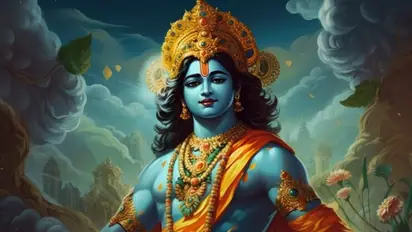Ram Navami 2024: Know why it is significant to celebrate the birth of Lord Ram

Synopsis
Ram Navami marks the birth or the appearance day of Lord Ram, an incarnation of Lord Vishnu. It usually falls in the Hindu calendar month of Chaitra, which typically falls in March or April in the Gregorian calendar.
Ram Navami is a widely celebrated festival observed by devotees of Lord Shri Ramchandra across India and around the world. It falls on the Navami tithi (ninth day) of the bright half of the Hindu lunar month of Chaitra each year. Lord Shri Ram, the seventh incarnation of Lord Vishnu, manifested alongside His brothers Bharata, Laxmana, and Shatrughna during the Tretayuga. They were born as the sons of King Dasharatha in the illustrious Surya dynasty of King Ikshavaku.
This year Ram Navami will be celebrated on April 17.
Significance of Ram Navami:
The significance of the Ram Navami festival lies in the triumph of good over evil. Despite the formidable power of Ravana, who possessed ten heads, Lord Ram defeated him with just one arrow. In doing so, Lord Ram demonstrated His sovereignty over the six material enjoyments, establishing Himself as the ultimate divine authority.
In the Brahma Vaivarta Purana, Lord Brahma elaborates on the attributes of the Supreme Lord. He defines Bhagwan, the Supreme Personality of Godhead, as one who possesses all riches (Aishwarya), strength (Virya), fame (Yasha), beauty (Shree), knowledge (Gyana), and renunciation (Vairagya). This proves that only Lord Ram is the greatest and the most influential personality in the universe. Therefore the defeat of Ravana was inevitable.
How did Lord Ram appear on Earth?
According to the Bhagavatam Purana, Lord Vishnu's two gatekeepers, Jaya and Vijaya, were cursed by the four Kumaras—Sanaka, Sanatana, Sanandana, and Sanat. The curse mandated that they would be born on Earth three times as demons and become enemies of Lord Vishnu. Both of them took birth as the sons of Pulasthya Brahman. From birth, they were ruthless; they captivated many demigods and demi-goddesses. Seeing all this, Lord Vishnu appeared as the son of King Dashratha.
According to the Valmiki Ramayana, King Dashratha had 353 queens, among whom only three were prominent: Kaushalya, Kaikeyi, and Sumitra. Dashratha was renowned for his greatness, power, and majesty, capable of maneuvering his chariot in ten directions.
Despite being a great and powerful king, Dashratha faced constant despair due to the absence of a son who could inherit the throne of the Raghukula dynasty. In response to this concern, Sage Vashishtha suggested that he perform the Putra Kameshthi sacrifice. Through this ritual, Dashratha received a bowl of kheer prasadam, which he distributed equally among his three queens. Kaushalya, being the eldest among them, received the first half portion of the kheer. While consuming the prasadam, she fervently wished for a son who could rule over the entire earth. As a result of her sincere prayer, she was blessed with Lord Shri Ram as her son.
Mother Kaikeyi also partook in the kheer prasadam and earnestly wished that her child would always adhere to the path of righteousness (dharma). Consequently, she was blessed with Bharata as her son.
Mother Sumitra, receiving two portions of the kheer prasadam, wished fervently that her sons would serve their elder brothers with utmost love and respect. Thus, she was blessed with two sons, Laxmana and Shatrughan, who were dedicated to serving their elder siblings throughout their lives.
Lord Rama accepted queen Sita as His wife. Their entire life story is presented in the Ramayana book, composed by Sage Valmiki.
Shri Ramchandra was known as Maryada Purushottam. He taught the whole society how to be an ideal son, an ideal brother, an ideal husband, an ideal friend, an ideal king and an ideal father.